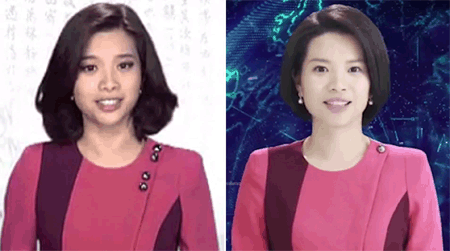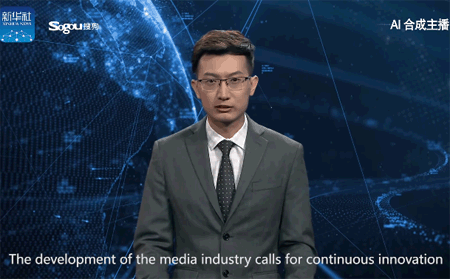Will artificial intelligence replace human news anchors on television? In China, it is already happening.
In the next two decades, almost half of American jobs may be at risk because of advances in technology. How will A.I. affect broadcast media?
By Ruozhu Zhao
(Zhao is an associate professor in the Communication University of China, and a visiting scholar to the Center. Contact Zhao at [email protected].)
In 2013, Michael Osborne and Carl Benedikt Frey of Oxford University conducted a research study titled “The Future of Employment” that investigated the futures of 702 of the most common jobs. For each job, they considered the question, “Can the tasks of this job be sufficiently specified, conditional on the availability of big data, to be performed by state-of-the-art computer-controlled equipment?”

Xin Xiaomeng (right), the first female artificial intelligence news anchor, from China’s state-run press agency Xinhua. Xin Xiaomeng was modeled after flesh-and-blood journalist Qu Meng (left). To see Xin Xiaomeng at work, go here.
The groundbreaking research by Osborne and Frey has been cited more than 5,000 times, unnerving workers in all sectors of the economy and providing a new perspective on the impact of new technology on the workforce globally.
According to their analyses, up to 47 percent of American jobs were at risk of being automated by the mid-2030s. Some jobs – telemarketers, tax preparers, and sports referees – were at a higher risk than others, including recreational psychologists, dentists, and physicians. They also ranked “Radio and Television Announcers” 171st out of 702, having a 0.1 probability of being replaced by artificial intelligence.
Since the study was released, this trend of automation has been picking up pace, and A.I. has started to invade many aspects of the news business. Many media organizations such as The Guardian, Associated Press, Bloomberg, Forbes, and Reuters have taken advantage of A.I. systems. For instance, Forbes has rolled out an A.I.-powered content management system that suggests content and titles, and The Washington Post released Heliograf that can generate entire articles from quantitative data.
All of these advancements have made Xin Xiaomeng almost indistinguishable from the human reporter after which it is modeled. So far, as an “employee” of Xinhua, Xin Xiaomeng has reported more than 3400 pieces of news with over 10,000 minutes of reporting time. As Quartz points out, “China has taken a big step towards weeding out traditional journalists.”
The same technological developments can be observed in news and journalism in China, but with on-screen images that take A.I. to a new level of presentation. According to a 2017 China Youth Daily survey, 53.6 percent of respondents believed that news anchors and journalists may be the first to be replaced by artificial intelligence. Public sentiment aside, the prediction of A.I. replacing news anchors has gradually become a reality – not just as automated delivery of the news, but with animated, human-like images that deliver the news just as their human counterparts do.
Xin Xiaomeng, the world’s first female A.I. news anchor, made her debut in China in March 2019. Developed by Xinhua News Agency and modeled after its reporter Qu Meng, Xiaomeng covered part of China’s National People’s Congress with such authenticity that it quickly attracted the attention of the public and media organizations from all over the world.

The world’s first A.I. news anchor made his debut at the Fifth World Internet Conference in 2018, introducing himself in English. See this debut here. For a presentation four months later by A.I. anchor Xin Xiaohao — already showing significant improvement over this debut anchor with better facial expressions and hand gestures — go here.
In fact, before Xin Xiaomeng, Xinhua had already created two male A.I. news anchors in 2018, modeled after Xinhua reporters Qiu Hao and Zhang Shao. While Qiu Hao specialized in news reporting in Chinese, Zhang Shao specializes in reporting in English. CCTV and the Keda Xunfei Technology Group had also previously used similar A.I. technology with voice recognition in news reporting.
However, different from previous A.I. new anchors, Xin Xiaomeng has been upgraded by Xinhua with Sougou Clones’ technical support. While previous A.I. anchors could only read news, Xin Xiaomeng is able to adjust “her” postures based on the news content like a human being might while standing behind a podium.
In addition, Xin Xiaomeng not only sounds like a human reporter with high-fidelity voice integration techniques, but through intensive algorithmic learning it can also exhibit facial expressions appropriate to the context, report with more colloquial words and syntaxes, and even create its own reporting style.
All of these advancements have made Xin Xiaomeng almost indistinguishable from the human reporter after which it is modeled. So far, as an “employee” of Xinhua, Xin Xiaomeng has reported more than 3400 pieces of news with over 10,000 minutes of reporting time. As Quartz points out, “China has taken a big step towards weeding out traditional journalists.”
How do reporters feel about this emerging trend? How do they react to this technological development? According to Qu Meng (the Xinhua reporter after whom Xin Xiaomeng is modeled), the arrival of A.I. reporters creates benefits as well as challenges for human reporters.
One benefit is that A.I. reporters never get tired of news reporting and free human anchors from repetitive and tedious work. Typically, on a work schedule of eight hours a day, human reporters broadcast news in the studio following a teleprompter and dub news programs in the recording room according to the articles provided by editors. They need to deal with a large amount of text on a daily basis, and must correctly pronounce every word, all of which can be stressful and exhausting.
A.I. reporters can provide relief, which is best exemplified in Xinhua’s A.I. reporter Qiu Hao, who if called upon, could report news without a break for 24 hours a day, seven days a week. With A.I. anchors taking over the mundane work, another benefit is that reporters can then focus more on the creative aspects of news reporting, such as conducting in-depth interviews and managing shows, according to Qu Meng.
The trend of automation has been picking up pace, and A.I. has started to invade many aspects of the news business. Many media organizations such as The Guardian, Associated Press, Bloomberg, Forbes, and Reuters have taken advantage of A.I. systems. For instance, Forbes has rolled out an A.I.-powered content management system that suggests content and titles, and The Washington Post released Heliograf that can generate entire articles from quantitative data.
Do human reporters face a threat from A.I. reporters? According to Qu Meng, yes. From initial algorithmic training to final deployment, an A.I. reporter like Xin Xiaomeng can be produced in little more than a month, and thousands of them can be manufactured to do news reporting from anywhere. Qu Meng argues that news agencies will be able to deploy A.I. reporters on a large scale without much difficulty.
How can human reporters navigate this new media landscape and reduce their unemployment risk? Not surprisingly, jobs requiring creative and social intelligence are deemed least likely to be automated. Both the current television news anchors and college students majoring in broadcast journalism need to adapt to new roles and acquire new skills. If they can only read news articles well, they will be eliminated in the competition against A.I.
News anchors will have to develop multiple skill sets and be well-informed to provide social commentary and conduct engaging interviews. In addition, news anchors will have to go out into the field where events are happening. From there they will be able to offer observations and stories, instead of sitting in studios and reading other people’s scripts.
In other words, jobs will be redefined rather than vanish. As is pointed out by Sally Prakash, Vice President of Digital Product Development and Chief Information Officer of the Washington Post, “A.I. is not about eliminating journalists; it’s about making the newsroom more efficient.”
Of course, the issues involving A.I. reporters extend far beyond mere newsroom efficiency. Whether A.I. reporters will be widely used in place of human reporters will depend on many other factors besides technology itself, such as regulatory decisions, political pressure, and societal acceptance.
But whether news anchors are A.I. or human, one issue is clear: in this time of change and uncertainty, broadcast journalists need to deliver personalized, credible, and diversified news to their audiences, telling stories that only human beings can create — whether those stories are ultimately reported on the air by people or digital images.
__________
July 18, 2020

